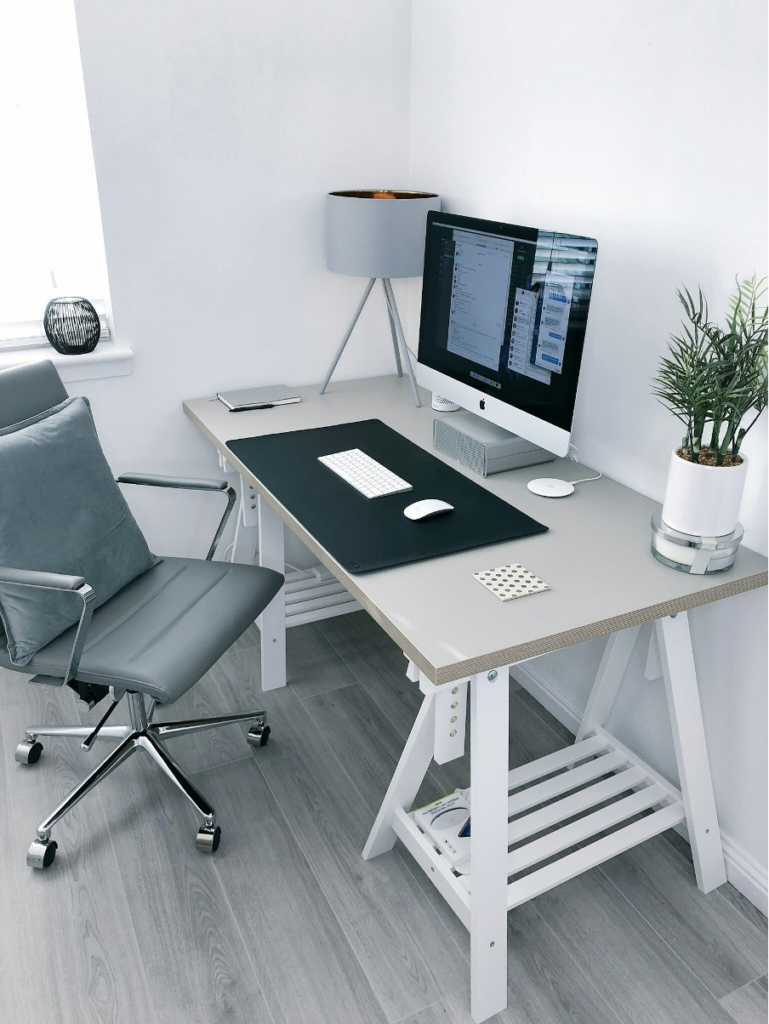Working from Home:
Health and Safety Guide 2025
Love it or loathe it, the days of working exclusively in an office environment are quickly becoming a thing of the past.
In fact, recent studies show that only 22% of UK workers attend the office 5 days a week, while the remaining work from home at least part of the time.
Contents
- Your Legal Responsibilities When Employees Are Working Remotely
- What the Health and Safety Executive (HSE) Expects
- What Should a Home Risk Assessment Cover?
- Equipment and Adjustments
- Mental Health and Work-Life Balance
- Lone Working: Don’t Let People Fall Through the Gaps
- Reasonable Adjustments for Home Working
- What You Need to Do Now
- We’re Here to Help You Work Smarter and Safer
With more people working from home, embracing hybrid working, or spending time away from the office, the way we approach health and safety has shifted. But one thing hasn’t changed: your legal duty to keep your people safe – wherever they’re working.
Whether your teams are fully remote working, popping in a few times a week, or managing their own schedule at home, you still have a responsibility to protect workers, support mental health, and reduce safety risks.
Here’s what employers need to know in 2025 to meet their obligations and create safe, productive, and sustainable working environments at home or anywhere else.
Flexible working should not become out of sight, out of mind! As the working environment continues to evolve, so must the way we manage safety, wellbeing and legal compliance.”— Russell Corlett, Head of Omny Safety

Your Legal Responsibilities When Employees Are Working Remotely
When it comes to home-working health and safety, the law is clear. The Health and Safety at Work Act 1974 requires you to take all reasonable steps to ensure the health, safety, and welfare of your employees—even when they’re away from the workplace.
That includes:
- Identifying and reducing potential risks
- Conducting a suitable home risk assessment
- Supporting employees’ mental health
- Providing basic equipment for safe working
- Making reasonable adjustments where needed
Insurance and Employer Liability
You’ll need to ensure your existing insurance policies cover remote workers adequately. You should also remind employees to check their personal home insurance policies and agreements with mortgage providers or landlords to make sure there aren’t any issues related to remote working.
These responsibilities apply to home workers, remote workers, lone workers, and disabled workers equally. The environment might change but your duty of care does not.
Remote and Hybrid Work Contracts
When formalising hybrid or remote work arrangements, employers should clearly set out specific terms in contracts. Important clauses include working hours, expected availability, rules around expenses and equipment use, insurance and liability considerations, and standards for data security and confidentiality.
What the Health and Safety Executive (HSE) Expects
According to the Health and Safety Executive, employers must assess whether home working is suitable and safe. For low-risk activities, like computer-based roles, a self-assessment may be enough so long as it’s supported with guidance, follow-up, and the right tools.
You also need to make sure that remote working employees know how to raise any safety concerns and that there’s a clear process in place to support them.
“When people work remotely, communication replaces supervision. That’s why regular check-ins aren’t just good culture they’re a compliance tool.”
— Russell Corlett
What Should a Home Risk Assessment Cover?
A home risk assessment helps you identify any home risks that could impact your team’s safety or wellbeing.
Here’s what to look for:
| Risk Area | What to Consider |
| Display Screen Equipment | Is the setup safe, ergonomic, and comfortable for long periods of use? |
| Trailing Leads & Trips | Are wires, cables, or other trip hazards safely managed? |
| Electrical Safety | Are sockets overloaded? Are devices used correctly and safely? |
| Lone Working | Does the worker have regular contact with a manager or colleague? |
| Work-Related Stress | Are they working long hours without regular breaks? Do they have clear boundaries? |
| Mental Health | Do they feel isolated, overwhelmed, or unsupported? |
| Fire Safety | Is there a fire alarm, a clear exit route, and a basic understanding of emergency steps? |
You’ll need to record the significant findings, share any actions required, and check in regularly to make sure nothing’s changed.

Preventing Common Remote Working Injuries
Prolonged home working can increase the risk of injuries like back pain, neck strain, eye fatigue, or repetitive strain injuries. There are steps you can take to prevent this in your workforce, for example, provide specific ergonomic guidance, encourage regular stretching breaks, proper equipment use, and periodic posture checks. Simple actions like screen breaks and posture correction can go a long way in keeping your team healthy.
Emergency Procedures and Accident Reporting
Make sure your remote workers know exactly what to do in case of an emergency. Provide clear guidance on how and when to contact the company and emergency services, and ensure you keep updated emergency contact details on file. Also, make sure to clearly define your process for reporting accidents or injuries sustained during remote work, in line with RIDDOR requirements.
Equipment and Adjustments
It’s not enough to tell employees to work safely; you have to give them the tools to do it.
That includes:
- Basic equipment like chairs, desks, screen risers, or monitor arms
- Information on how to work safely with display screen equipment
- Guidance on taking regular breaks and setting up their workspace
- Reasonable adjustments for disabled workers or those with specific needs
“You don’t need to replicate the office, but you do need to support the person. That might mean a better chair or it might mean a weekly check-in. Both are safety strategies.”
— Russell Corlett
If your people are using personal equipment to work, make sure they understand how to check it’s safe and that they’re covered under your insurance policies if needed.

Mental Health and Work-Life Balance
Working remotely can blur the lines between work and personal life. And while flexibility has huge benefits, it can also bring challenges like burnout, stress, and feeling isolated.
As an employer, you can reduce work-related stress and promote a better work-life balance by:
- Encouraging regular breaks and downtime
- Promoting a clear end to the working time day
- Offering support for employees’ mental health
- Reviewing mental health policies with hybrid working in mind.
- Creating a culture where it’s okay to ask for help
Engaging remote working and home working employees with health and safety can be a challenge. By being proactive, you not only meet your legal obligation, you help your people feel valued and supported.
Managing Conflict, Inclusion, and Harassment
Remote working can sometimes amplify misunderstandings or exclusion. Clearly communicate acceptable behaviours and provide straightforward channels for raising issues around bullying, harassment, or conflict. Regular training for managers can help create an inclusive remote working culture where everyone feels safe, heard, and supported.

Work-Life Balance, Presenteeism, and Sick Leave
Clearly communicate expectations around working hours to prevent burnout. Actively discourage presenteeism, ensuring employees understand it’s important—and encouraged—to take appropriate sick leave when unwell. Promoting healthy boundaries helps your teams stay productive and balanced.
Lone Working: Don’t Let People Fall Through the Gaps
When people are working with little or no direct supervision, it’s easy to feel disconnected. That’s why it’s essential to have systems in place for regular check-ins and support.
Good Practices for Lone and Remote Workers:
- Schedule regular one-to-ones or informal chats
- Make it clear how to report health and safety concerns
- Use tools for real-time updates, task tracking, or wellbeing check-ins
- Identify any employees who may be at higher risk (new starters, those with health issues)
This isn’t just about oversight—it’s about inclusion. Every worker should feel part of the team, even if they’re working 100 miles away.
Reasonable Adjustments for Home Working
If any of your employees have a disability, health condition, or specific need, you’re required by law to make reasonable adjustments to help them work safely and effectively.
This could include:
- Providing alternative equipment (keyboards, screens, software)
- Adjusting hours or deadlines
- Offering different ways of working to reduce stress
Domestic Abuse and Safeguarding
Remote work can sometimes conceal personal difficulties, such as domestic abuse. Stay vigilant for signs your employees might be experiencing issues at home, and ensure you provide confidential, discreet channels to offer support or connect them with relevant resources.
You’ll also want to ensure your health and safety processes take account of these workers’ needs from the outset—not as an afterthought.
What You Need to Do Now
Here’s a quick resource to help you manage home workers’ health and safety effectively:
| Action | Why It Matters |
| Carry out a home risk assessment | Essential for compliance with UK health and safety law |
| Provide suitable equipment and DSE guidance | Helps employees work comfortably and avoid injury |
| Stay in regular communication | Reduces lone working risks and supports employee wellbeing |
| Monitor working hours and encourage breaks | Prevents burnout and improves work-life balance |
| Offer mental health support and resources | Protects staff and builds trust |
| Make reasonable adjustments for those who need it | Meets your legal duty and supports disabled workers |
| Review and update policies regularly | Keeps your approach aligned with changing risks and legislation |
“Health and safety should never be treated as a checklist exercise. When done well, it becomes a way to build trust, drive performance, and support better work.”
— Russell Corlett
Quick Reminder: Remote Employee Handbooks
It’s good practice to create or update your employee handbook to include a dedicated section on remote or hybrid working. Clearly define expectations, communication standards, health and safety processes, wellbeing resources, and instructions on how to raise any concerns.
We’re Here to Help You Work Smarter and Safer
At Omny, we work side by side with businesses to create safe, flexible, and legally sound ways of working. We’ll help you take the weight off your shoulders, stay on top of your responsibilities, and focus on what matters: your people.
Our remote working support includes:
- Custom home working risk assessments
- Display screen equipment (DSE) advice and setup support
- Policy reviews and updates to meet legal requirements
- Training for managers and teams
- Practical advice on mental health, wellbeing, and reasonable adjustments
Whether you’ve got one person working from home or an entire remote workforce, we’ve got your back.

Let’s Make Remote Work Safe, Simple and Compliant
If you’re not sure whether your current setup meets 2025 standards or you want to build a more robust strategy for supporting remote and hybrid working, we’re ready to help.
Book a chat with our team to talk through your needs. We’ll help you work safely. And we’ll make it easy.



